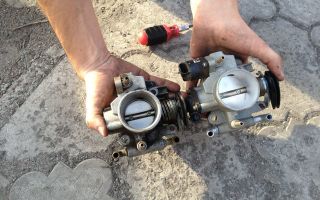Cleaning the throttle valve. 5 common mistakes when cleaning the throttle body yourself
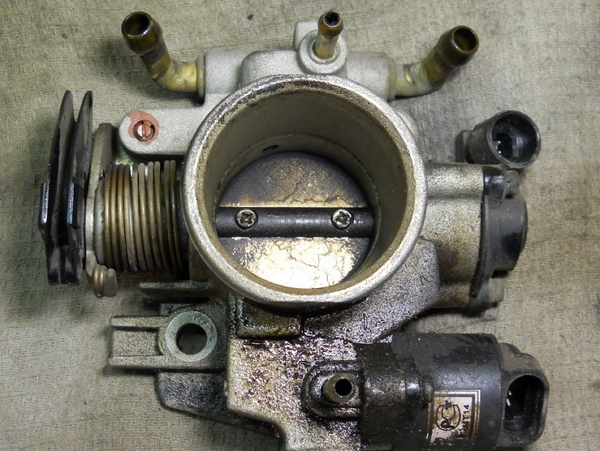

The task of the throttle valve (hereinafter referred to as DZ) is to regulate the amount of air supplied to the intake manifold. Its position is adjusted in accordance with the position of the accelerator pedal. The damper drive can be mechanical (using a cable) or electronic (using an electric motor).
The position of the remote control is recorded by a special sensor. It transmits the relevant information to the ECU, which in turn makes a decision on the amount of fuel supplied and changing the engine operating mode. You can read more about its structure and functions in additional material on our website.
Content
Signs of a dirty throttle valve
In order not to confuse the symptoms indicating excessive carbon deposits on the valve, it is better to first visually inspect it, and if there are no visible oil or coked deposits on the walls of the throttle assembly, then, with a high degree of probability, cleaning the throttle valve will not eliminate the problem.
themselves look like this :
- problematic engine starting;
- uneven engine operation;
- floating speed at idle;
- freezing engine speed;
- drops in speed until a complete stop.
Mistakes when cleaning the throttle valve
Many inexperienced car owners can incorrectly clean the throttle assembly, at a minimum risking not getting the desired effect, and at maximum - completely damaging and disabling the throttle body. Therefore, it is important to understand when to do the procedure, how to do it and what means to use.
Dirty throttle valve
Clean throttle
To properly clean the throttle body DO NOT :
- Clean the damper in any unclear situation (there are even jokes about this).
- Clean the damper without removing it (the effectiveness of such cleaning is insignificant, since often it is only possible to remove carbon deposits on the damper itself, and the internal walls and air channels of the damper are not cleaned).
- When cleaning with a rag, use excessive force, which can lead to damage to both the damper itself and the nearby TPS.
- Use brushes rather than soft materials. Such an error also quite often leads to loss of performance of the remote control, since on some throttle units the inner wall and damper are coated with molybdenum for even smoother air passage. This layer is often confused with plaque and is removed. As a result, the damper begins to either “bite” or allow excess air to pass through (the speed increases).
- Forgetting to teach the throttle after cleaning. Dampers with an electronic gas pedal require proper learning of the remote control in order to set the idle speed to the required value.
Cleaning the throttle valve on Mitsubishi and Nissan requires a special approach. You need to act carefully and carefully so as not to remove the protective coating, the so-called “patch” - a sealing coating along the contour of the remote protection. And also be sure to train the damper to set new engine operating parameters).
The throttle valve should be cleaned every 30-50 thousand km .
Adhering to all the above recommendations and taking into account the main mistakes that inexperienced car owners make, no more questions should arise about how to clean the throttle valve, be it mechanical or electronic. For cleaning you need a minimum of equipment and costs, just a carb cleaner and clean rags, as well as a screwdriver for dismantling the unit.
Cleaning algorithm
Now we will give a step-by-step algorithm for properly cleaning the throttle valve.
- First of all, you need to get to the damper itself. The design is different in different engines. But as a rule, to do this you need to remove the air duct that runs from the damper to the air filter.
- Dismantle the damper. To do this, unscrew several mounting bolts (2-4 pieces), and also disconnect the necessary connectors (for example, the connector from the absorber purge valve).
- To clean, you must use a carburetor cleaner. There is a wide variety of them, and in auto stores you can easily find a product in accordance with your preferences and capabilities (we will talk about them later).
- Using a rag and the mentioned product, you must thoroughly wipe the damper outside and inside.
- You also need to clean the protective grille (if your car has one).
- Assembly of the unit is carried out in the reverse order.
Remember that you need to clean the damper thoroughly so that the metal is as light as possible. This will ensure, after its installation, an increase in the dynamic characteristics of the machine.
An easy way to clean your throttle body
The correct way to clean the throttle body
Cleaning without removal
Also, many car owners are interested in the question of how to clean the throttle valve without removing it. Such methods do exist, but you must immediately understand that high-quality cleaning is only possible by dismantling the damper .
To do this, you will need a special product - an intake tract cleaner. You can use different brands. You can also use EGR valve cleaning fluid, WD-40, and solvents for cleaning.
So, the procedure without removing the node :
- As in the previous algorithm, you need to remove the air duct to get to the damper.
- With the damper closed, spray the surface with cleaning liquid and remove the cleaned dirt using a rag.
- Open the damper and remove dirt from the side surface.
- Make sure that the cleaning agent gets into all channels. The cleaning procedure is similar using a rag.
Let us repeat once again that for proper cleaning, the throttle valve must be removed from the car. And when installing it back, it is advisable to replace the damper gasket with a new one. Fortunately, its price is low.
Source: https://etlib.ru/blog/219-kak-pochistit-drosselnuyu-zaslonku
How to clean the throttle valve yourself?
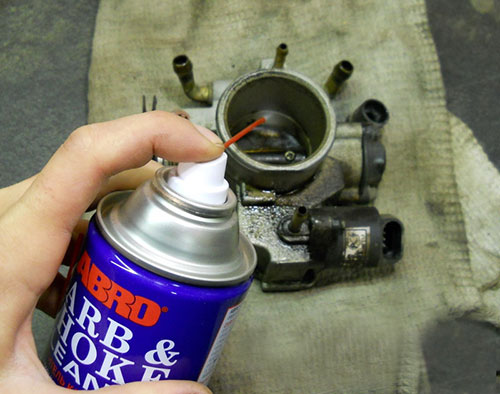
The throttle valve (hereinafter referred to as DZ) on a car serves to accurately dose the amount of air when preparing the air-fuel mixture, and engine operation in all modes depends on its good condition.
Causes of remote sensing pollution:
• Exhausted fuel and air filters;
• Poor quality fuel;
• Wear of the cylinder-piston group;
• Malfunction of the crankcase ventilation system.
The photo shows a dirty throttle valve
So, when the cylinder-piston group wears out, the breakthrough of gases into the engine crankcase increases, where carbon particles also enter along the way. This, in turn, in addition to oxidation of the engine oil, causes its contamination with various deposits.
After starting the engine, the operation of the crankshaft and connecting rods produces an oil mist in the sump, consisting of gases and various impurities, which enter the engine control unit through the crankcase ventilation system, causing the appearance of oil and tar deposits and a layer of durable soot.
All this, in turn, leads to the damper axis biting, its loose fit to the walls of the housing or its wedging during operation. Accordingly, this is reflected in the operation of the power plant, expressed in:
• unstable startup;
• floating idle;
• loss of dynamics and power;
• increased fuel consumption.
Before you start cleaning the remote control, if the above listed signs are detected, it is recommended to carry out a visual inspection of it. If there are no strong deposits or carbon deposits on the damper axis or diffuser walls, then most likely the problem is caused by other reasons and cleaning itself will not change anything.
dirty Subaru throttle.
Frequency of cleaning the damper
Based on the experience of servicing and repairing the remote control, the need to clean it arises after a mileage of about 30-50 thousand kilometers, or earlier when signs of severe contamination are detected.
Means for removing dirt from the assembly
Cleaning the DZ can be done with various available means, such as solvent, WD40 and similar preparations.
However, when using them, there is always some risk of their action on the inside of the motor.
Today, there are special developments specifically for performing such operations for cleaning heavy contaminants that are harmless to the engine; these are the most common preparations such as:
• LIQUI MOLY DrosselKlappen-Reiniger (LM-5111) – 520 rubles;
• Mannol Carburetor Cleanor – 115 rubles;
• ABRO Carb&Choke Cleaner (CC-220) – 200 rub.
Throttle cleaner from Liqui-Molly
All of these compounds do an excellent job of cleaning any contaminants in the throttle assembly, and each car owner can make a choice according to his preference.
Methods for cleaning the damper
Cleaning the throttle assembly can be done either in place, without removing it from the engine, or by dismantling it. Better washing and cleaning is only possible with the removal of the remote control, when it becomes possible to clean all its most vulnerable places.
This is explained by the fact that without removing the unit it is impossible to get to the internal walls and the passage of the air channels, which will be a significant disadvantage during operation and may not give the desired effect.
Cleaning without removal
In this case, it is necessary to remove the air duct to get to the damper. Next, using one of the cleaning products, apply it to the walls of the diffuser and the damper itself (the damper is closed), then wipe everything thoroughly with a clean rag (not leaving lint).
Cleared remote sensing
Then you need to put the damper in the open position and remove dirt from its sides. Make every effort to get the cleaner into all channels of the unit.
Cleaning should be done carefully until clean metal appears, trying not to apply significant force.
Cleaning with dismantling of DZ
• The air duct between the damper and the air filter housing is removed;
Disconnect the air duct pipe
• Unscrew the assembly fasteners and remove all existing connectors;
DZ removed
• Apply detergent to all elements of the assembly and visible channels;
• Thoroughly wipe the treated surfaces with a clean cloth;
Cleaned
• Reassemble in the reverse order of removal, installing a new sealing gasket;
• Connect to the car's ECU and “train” the damper with new parameters.
Errors when cleaning the throttle valve assembly
Despite the apparent simplicity of the cleaning operation, many car enthusiasts, due to inexperience, make mistakes that, in addition to not giving the desired effect, can also cause harm to the unit or disable it.
So, you should not make great efforts when cleaning, as this can damage both the damper itself and its position sensor. Also, you cannot clean the damper using hard brushes, since on some models the walls of the diffuser and the damper itself are factory-coated with molybdenum.
Due to inexperience, many people mistake this coating for carbon deposits and remove it. This can lead to either wedging or the appearance of a gap and excess air leakage.
Upon completion of the work, the unit is not trained (adapted) with the new engine operating parameters and the required idle speed is not set.
For stable operation of the engine and extending the “life” of the throttle valve, we recommend cleaning it if a malfunction occurs, as well as for preventive maintenance after the above-mentioned 30-50 thousand kilometers.
Source: https://avtoexperts.ru/article/kak-pochistit-drossel-nuyu-zaslonku/
Cleaning the throttle valve: products and liquids, how to rinse and clean it yourself, what it does and how best to do it
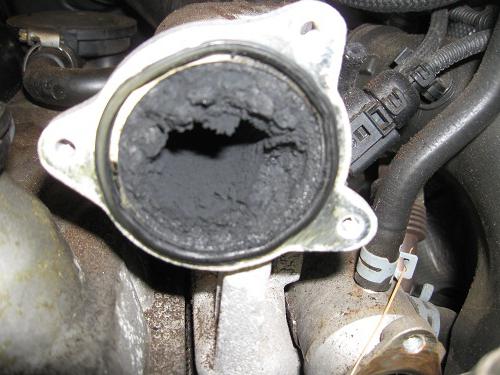
The function of regulating the air supply to the intake manifold of the power unit is performed by the throttle valve. Interacts:
- Mechanically driven;
- With an electric motor.
These mechanisms are responsible for the timely opening and closing of the damper. Cleaning the throttle body is done infrequently. Work must be performed only when there are clear signs of malfunctions in the operation of this unit.
Throttle valve before and after cleaning
What may indicate increased soot
The driver must know what signs can be used to identify a malfunction or malfunction of the unit. These include:
- Unstable, intermittent operation of the power unit. The car jerks at speeds less than 20 km/h;
- The idle speed “floats”, the power unit stalls;
- Possible freezing of engine speed;
- Dips in engine speed until a complete stop;
- The engine is difficult to start.
Cleaning the throttle body increases rpm
In this regard, the question arises of how to clean the throttle valve and what products to use. So, everything in order. There are two ways to resolve the issue. Clean the throttle valve yourself or contact a service station.
In exceptional cases, cleaning of the unit is carried out when the vehicle has been driven after 30 thousand km. In order not to create confusion and vacillation in this matter, you should adhere to the manufacturer’s recommendations.
Cleaning the unit: stages and sequence of work
There are two cleaning options: without removing the unit and after dismantling. In the first case, the effectiveness of soot removal will be minimal. Cleaning without removal is carried out only in extreme cases, since carbon deposits are removed only from the damper, and deposits remain on the walls and air channels.
Cleaning the throttle body helps increase revs
Complete cleaning gives a more noticeable effect. Work begins with removing the unit, which is located between the intake manifold and the engine air filter.
On cars from different manufacturers, the work may differ, but not significantly. On most vehicles this happens as follows:
- the corrugation connects the damper with the air purification filter: it must be removed first;
- Next, turn off the throttle position and absolute pressure sensor (if available and installed on the car);
- then you need to squeeze out the weight that secures the accelerator pedal cable;
- dismantle (disconnect) the coolant pipes. At this stage, work must be carried out very carefully. If the power unit has not completely cooled down, hot drops of technical fluid can cause a burn if they come into contact with human skin, remember this;
- Disconnect the crankcase gas and absorber ventilation hoses;
- Then you need to unscrew the fastenings of the throttle assembly and dismantle it.
Cleaning the throttle bodyCleaning the throttle bodyCleaning the throttle body
Having removed the mechanism, unscrew the idle speed control. Its washing and cleaning is highly desirable. To rinse the entire assembly, you must use special products.
Washing the throttle valve is possible using budget detergents ("Karbakliner") and more effective, but expensive ones. Read about it below.
Cleaning products
For complete dismantling, you can use the budget option mentioned earlier. But most often, washing is carried out with a carburetor cleaner: carbicleaner. It efficiently removes dirt and deposits in a couple of minutes.
Throttle Body Cleaners
For the work, you need a brush with soft bristles, or a brush, with which, after applying the chemical, you need to clean the unit.
But even after “spring cleaning” problems can arise. Don't be alarmed, it happens. You may find that after cleaning the throttle valve the speed fluctuates. This is a solvable issue.
Check that the sensors are connected correctly
You need to check that the sensors are connected correctly. There may have been an error during the build phase. After the cleaning procedure, you need to adjust and configure the throttle. Not all drivers know about this. Or the setup process is not being performed correctly.
If the setting is carried out incorrectly, then it is possible that the power unit will run at higher speeds constantly. This leads to increased fuel consumption.
The reasons are the same: incorrect adjustment and an error when connecting the sensors.
When the electronic throttle valve is cleaned, it needs to be adapted. The fact is that after work the position of the damper changes. But the electronic control unit (ECU) does not know about this and continues to dispense fuel according to previous indicators.
Expert advice
Use chemicals to clean the entire assembly. Don't forget about remote sensing channels. Apply coolant (cleaning liquid) and let it absorb. This takes 5-10 minutes. Remove stuck carbon deposits with a soft cloth.
Throttle valve after cleaning
It is not recommended to use brushes with metal fibers. Purchase cleaning products from auto/shops. Please read the recommendations carefully before use.
In custody
We hope that these simple tips and tricks will help you clean the throttle valve yourself. If you are not confident in your abilities, or do not have enough time, use the services of a service station, good luck.
Source: https://SwapMotor.ru/ustrojstvo-dvigatelya/chistka-drosselnoj-zaslonki.html
Why do you need to clean the throttle body?
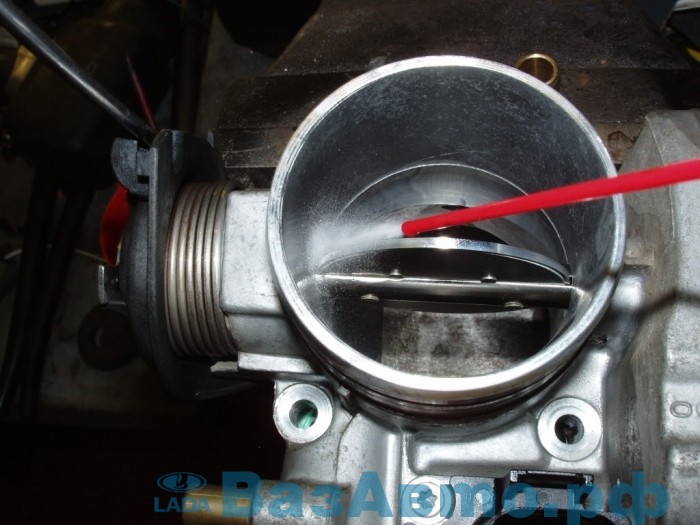
The throttle valve is a valve that is directly connected to the gas pedal of the car. The throttle valves and gas pedals on modern cars are electronic.
Operating principle of the throttle valve
Basic elements of the throttle valve
How does the driver control engine speed? By pressing the gas, he opens the throttle, increasing the diameter of the space through which the engine is supplied with air.
The more air enters the engine, the more fuel the engine ECU (computer) supplies, while maintaining the required air/gasoline ratio.
The large mass of the air-fuel mixture leads to an instant increase in speed (and power, respectively).
Checking operation after cleaning
The engine also contains a system such as a crankcase gas recirculation system. Gases accumulate in the crankcase, consisting of oil dust, exhaust gases, and fuel that has not had time to burn in the cylinders.
In accordance with modern environmental requirements, the designers decided to send these gases back to the cylinders for the purpose of afterburning them. The gases pass through the oil separator, but a small percentage of the oil still remains in them. Their path to the cylinders lies through the throttle valve.
Dust settling
Dust settling
This is where the oil dust mixes with regular dust . This black, sticky mass settles in the throttle working space, through which air flows into the engine.
The resulting layer affects the diameter, and therefore the throughput of the throttle . This affects the operation of the engine, its response to sudden pressing of the gas pedal. In addition, the oily mixture can get into the IAC, which adversely affects the idle speed. Therefore, it is necessary to clean the throttle from unwanted formations inside it.
Symptoms that may occur when the throttle is clogged
- When the throttle valve is clogged, there is some sluggishness in the response to the gas pedal . An engine with a clean throttle body responds to the accelerator much more quickly.
- Accumulated dirt in the throttle restricts air flow and can cause the engine to run rough at idle, the speed “floating”.
- The vehicle may at low speeds and speeds.
- With a very high degree of pollution, unauthorized engine stops are possible, i.e. the car stalls .
- Fuel consumption. The engine ECU (computer), recognizing that the air flow is too weak, increases idle speed, thereby increasing fuel consumption .
What to do to prevent the damper from getting dirty too quickly
Its condition will depend on the frequency of replacing the air filter, the use of high-quality internal combustion engine oil, and the serviceability of the oil separator of the crankcase gas recirculation system. In general, the cleaning procedure is not labor-intensive and not expensive.
Therefore, if the above symptoms occur, or simply during maintenance, it is recommended to check the condition of the throttle valve.
The resource of the node itself is very high, but it is worth keeping an eye on it, since it performs quite important and delicate work.
Fast throttle method
Conclusion
Throttle valve contamination is a natural phenomenon for it . Cleaning the throttle, depending on operating conditions, is done quite rarely, approximately once every 100 thousand kilometers. The degree of contamination is easy to determine by eye, and if the metal inside is covered with a black, greasy layer of dirt, then it’s time to clean it.
Source: http://carfrance.ru/zachem-nuzhno-chistit-drosselnuyu-zaslonku/
How to clean the throttle valve? – Kolesa.ru
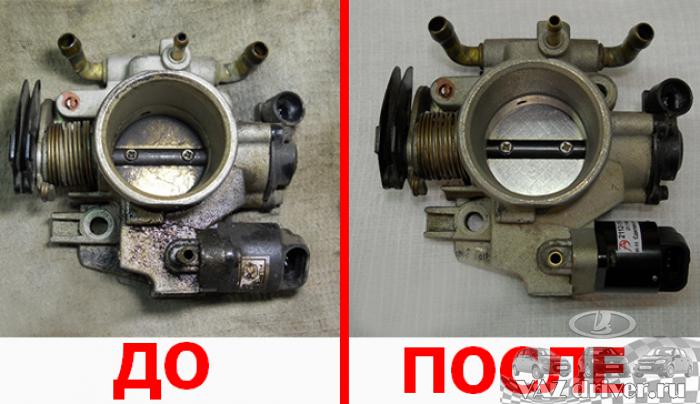
No matter how hard managers of car dealerships and banks try, the bulk of cars purchased in Russia ended up in the hands of new owners from the secondary market. And not all of these vehicles are repaired at the dealer; many owners prefer to service them on their own.
And what don’t they do when their purchase stops driving as expected, idles like an old tractor, and consumes more gasoline than a camel does water after crossing the Sahara... But sometimes it’s enough just to clean the throttle valve, and the car will move again like New.
Or almost like new.
What is a throttle valve? This is the mechanism of the intake system, which is responsible for supplying air to form the fuel-air mixture. Most budget cars are equipped with a basic mechanically operated damper.
We will not talk about electronic dampers, the intricacies of which are quite difficult to understand, and you can only break them completely with your own hands.
We are talking about a simple device that can often be seen by removing the air filter housing.
However, sometimes the filter is located on the side, then the throttle valve will have to be looked for somewhere between it and the intake manifold. But if you don’t find it there either, then either your car has a carburetor, or it’s simply not worth reading further, but it’s better to get ready and go to a car service center. Especially if symptoms indicating the need for cleaning are present.
The most typical of them are unstable operation at idle and periodic “freezing” of revolutions after releasing the gas pedal.
Do not forget that the reason for the “excessive” idle speed is not always in the throttle valve; it can also be in other elements of the fuel system or ignition.
And yet, the cleanliness of the throttle plays a very significant role in the operation of the power unit.
How does the throttle valve condition affect idle speed? The fact is that there are usually two devices on the damper - a throttle position sensor (TPS) and an idle air regulator (IAC), which is often also called a sensor.
These mechanisms not only allow you to “give gas” when you press the corresponding pedal, but also help maintain optimal shaft speed depending, for example, on the load on the on-board network.
I say “help”, because if you unscrew, say, the power steering sensor, then when you turn the steering wheel, the idle speed will still jump, even if the throttle valve and idle speed control are working perfectly. Electronics, there’s no escape from it.
Why does the damper have to be cleaned periodically?
The fact is that the air entering it is far from laboratory sterility.
It contains both solid suspensions and dust - everything that the air filter did not retain (which we always change on time, right?) All this dust is pulled into the engine by the vacuum in the intake manifold, but not everything gets there, some of this rubbish settles on the throttle body and directly on its damper. This is helped by the oil suspension that remains on the walls of the mechanism.
Where is she from? The fact is that there is a pipe going into the throttle that comes out of the valve box cover. And there is always a small concentration of oil mist there.
If the engine is already “tired”, and also well (for example, the piston rings are worn out), then there will always be more oil particles, which means that the throttle valve will become more contaminated. In advanced cases, the damper will become so overgrown with dust deposited on the oil film that the mechanism may periodically “stick.”
And more often, the cause of the malfunction will be precisely in the idle air regulator, which is installed on the throttle body. And here cleaning the device will become almost inevitable.
We all understand perfectly well that in some services there are not very decent people (not all, of course) who don’t really want to work. And then they manage to wash the damper without removing it at all.
Or - which happens more often - they do not touch the idle air control, which is why the work is actually completed, but the problem remains.
Therefore, we will show you how to do it correctly, and even if it takes a little longer, a little more difficult, it will provide a good result.
To work, we need a minimum set of tools and materials (a screwdriver, a pair of wrenches, a brush and a regular cleaner that can be bought at any store), as well as star heads.
The latter is necessary only because for example we took the K7M engine, known to admirers of the wonderful Renault Logan cars .
This motor is simple, its design does not contain any original solutions, so by looking at how we clean the damper of this unit, you can learn how to do this on any other budget motor. So, let's start disassembling.
The main thing is accuracy!
While I was blinking with my eyes and the camera shutter, the Logan Shop car service technician, Alexey Teleshov, had already removed the air pipe. I think everyone can handle this. Then unscrew the air filter housing. We remove it as an assembly; there is no need to take out the element itself (unless you decide to change it at the same time).
At the same time, we check the condition of the rubber seals through which the housing is attached to the motor. Over time, they dry out, and since the threads on the bolts are not cut to the head, even heroic strength and banal stupidity will not allow these seals to be tightened with a wrench.
The play itself is not so bad, but a good tightening ensures that air does not leak into the throttle valve in addition to the air filter, and the rattling of the filter housing is also not the most pleasant thing in the world.
After unscrewing the bolts, slightly lift the housing and disconnect the pipe from below, then remove the filter housing to the side. The throttle appears right in front of us.
Please note: there is a rubber O-ring between the filter housing and the damper. If it remains on the damper, we remove it and put it on the filter - this will make it easier to put everything back together.
Since the engine is not installed on a Rolls-Royce , on the damper we see a mechanical rod that connects the damper itself to the throttle cable through the rocking sector. It needs to be removed.
No force or fanaticism: we slightly pry it and move it to the side, after which it flies off the tip on its own. Now we disconnect the throttle position sensor and the idle air control. Everything is simple here: we press out the connectors and remove them from the sensors.
If it doesn’t work out right away, we look for which direction to press and pull; there’s no need for excessive force here either.
In general, all today's work requires more accuracy than physical preparation. Now we bow our heads and look at the base of the throttle valve. And we see a fixing bracket there, which we immediately remove. Now you can pull out the damper itself. We are already doing well, but only half.
Before washing the unit, do not forget to close the hole in the intake manifold, using an ordinary clean rag or napkin: the dust that gets there will not do any good to the engine.
Now it's time to poke around the throttle valve a little. You need to remove the idle speed control from it. To do this, unscrew the two screws and pull it out of the damper body. And we are horrified: the tunnel under it is covered in plaque! But we just got our hands dirty in order to get rid of this disgrace.
You can wash it with anything, even with a regular brush and carburetor cleaner. Just don’t forget that under the idle speed control there is also a rubber ring that you don’t need to lose or soak in gasoline or solvent so as not to destroy it.
Technical maniacs and perfectionists clean the damper to a mirror shine. Please, no one will prohibit this.
But we won’t act too fanatically, and there’s no point in that: outside it will still be covered in dust. Our first priority is to clean it from the inside.
We ensure that there is no trace at the point of contact between the damper and its body; as soon as this edge goes away, we consider the work completed.
After cleaning, the entire damper should be dried. You can just leave it to lie, but we use compressed air: it’s faster. But if you don’t rush, then while the damper is drying, you can work on the idle air control. Here we are primarily concerned with the stock: it must be absolutely clean.
By the way, when flushing the damper, do not forget to thoroughly clean the well under the regulator; if plaque remains there, the operating efficiency will be very low.
After all the operations performed, we consider the work completed. More precisely, its dirty part. It's time to get down to the more pleasant, purer component of it - the assembly.
We smear and take our time
If you manage to disassemble the unit, then assembly will not be difficult. We put the idle speed control back in place and return the damper to where it was pulled out from (it should fall into the groove, if it didn’t get there, and God didn’t hurt us by force, then there is a chance to go to the store for a new damper), tighten the bracket securing it.
Before installing the rod, it is advisable to lubricate the tips with any grease, at least lithol. We install the rod and check its progress with our hands: nothing should interfere with it, there should be no “biting” or jerking. We put on the ventilation pipe (from the bottom of the air filter housing, the one that was removed at the beginning of work), tighten the housing bolts.
The last thing to put on is the air pipe.
It's time to start the engine. In rare cases, after the first start the speed may rise slightly. If this happens, turn off the engine and start it again. After a few tries everything should return to normal.
But if you didn’t just clean the damper, but changed the idle speed regulator, then such a circus with speed is almost inevitable: the regulator does not immediately enter the working position. At its core, it is a stepper electric motor with a valve, and it adapts every time it is started. This is a completely normal situation and there is no need to be afraid of it.
After assembly and testing, all that remains is to say: “Who’s great? I'm done!" And be glad that you managed to save a certain amount of money.
By the way, this amount may vary. In St. Petersburg, our work specifically will cost an average of 700–750 rubles. In other regions, prices may well be higher or lower.
You should not look for those who take on this work too cheaply - most likely they will do it poorly, although it is quite possible to do it on your own in 30-40 minutes. However, this also applies to many other procedures, which we will definitely talk about later.
Finally, one last question: how often should the damper be cleaned? Everything here is individual: if gasoline flows instead of blood, and there is a desire to “go away” even despite the 1.5-liter engine with 80 “horses,” then you will have to clean it more often (for 40–50 thousand you can get it completely dirty: more revolutions - more oil dust). If you don’t get violent on the road, then it’s worth looking at the damper after thousands of miles. But if the engine is not in the best technical condition, the damper will be dirty until you start repairing the CPG.
For assistance in preparing the material, we thank the network of specialized stores and car services “Logan-Shop” (St. Petersburg, Shkolnaya St., 73/2, tel: 928-32-20)
Survey
Have you ever had to clean your throttle body?
- Yes, and on your own! 57%, 18711871 57%
Source: https://www.kolesa.ru/article/tryom-kak-sleduet-kak-chistit-drosselnuyu-zaslonku-i-zachem-eto-nuzhno
How to clean the throttle body
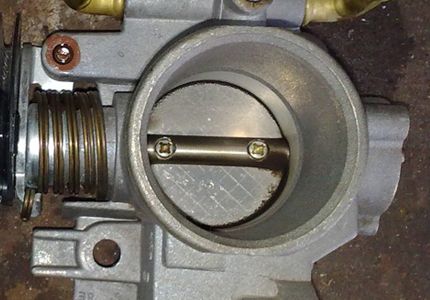
The task of the throttle valve (hereinafter referred to as DZ) is to regulate the amount of air supplied to the intake manifold. Its position is adjusted in accordance with the position of the accelerator pedal.
The damper drive can be mechanical (using a cable) or electronic (using an electric motor). The position of the remote control is recorded by a special sensor.
It transmits the relevant information to the ECU, which in turn makes a decision on the amount of fuel supplied and changing the engine operating mode.
Signs of a dirty throttle valve
In order not to confuse the symptoms indicating excessive carbon deposits on the valve, it is better to first visually inspect it, and if there are no visible oil or coked deposits on the walls of the throttle assembly, then, with a high degree of probability, cleaning the throttle valve will not eliminate the problem.
themselves look like this :
- problematic engine starting;
- uneven engine operation;
- floating speed at idle;
- freezing engine speed;
- drops in speed until a complete stop.
Mistakes when cleaning the throttle valve
Many inexperienced car owners can incorrectly clean the throttle assembly, at a minimum risking not getting the desired effect, and, at maximum, completely damaging and disabling the throttle body. Therefore, it is important to understand when to do the procedure, how to do it and what products to use.
Dirty throttle bodyClean throttle body
To properly clean the throttle body DO NOT :
- Clean the damper in any unclear situation (there are even jokes about this).
- Clean the damper without removing it (the effectiveness of such cleaning is insignificant, since often it is only possible to remove carbon deposits on the damper itself, and the internal walls and air channels of the damper are not cleaned).
- When cleaning with a rag, use excessive force, which can lead to damage to both the damper itself and the nearby TPS.
- Use brushes rather than soft materials. Such an error also quite often leads to loss of performance of the remote control, since on some throttle units the inner wall and damper are coated with molybdenum for even smoother air passage. This layer is often confused with plaque and is removed. As a result, the damper begins to either “bite” or allow excess air to pass through (the speed increases).
- Forgetting to teach the throttle after cleaning. Dampers with an electronic gas pedal require proper learning of the remote control in order to set the idle speed to the required value.
The throttle valve should be cleaned every 30-50 thousand km .
Adhering to all the above recommendations and taking into account the main mistakes that inexperienced car owners make, no more questions should arise about how to clean the throttle valve, be it mechanical or electronic. For cleaning you need a minimum of equipment and costs, just a carb cleaner and clean rags, as well as a screwdriver for dismantling the unit.
Source: https://avtodoc24.ru/ochistka-drosselnoi-zaslonki/
How to clean the throttle valve?
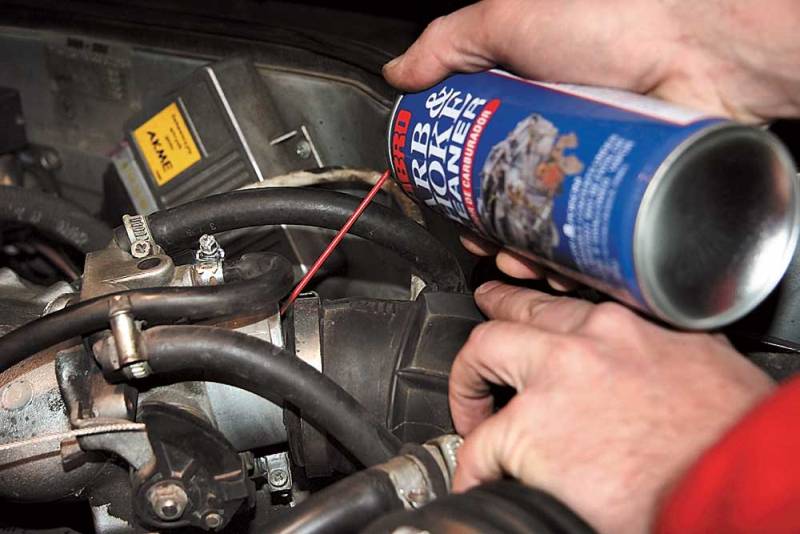
When using a car for a long time, its engine may begin to work unstably - at idle the speed is greatly reduced, starting causes some difficulties, and when driving at low speed the car begins to twitch. The cause of this is contamination of the throttle valve.
This is what you should pay attention to when such symptoms appear, while many drivers first check spark plugs, injectors and other components of the fuel system.
Cleaning the throttle valve will help you cope with such troubles, which can be done without turning to a professional mechanic.
Content
- Causes
- Quick cleaning
- Complete cleaning
- Motor protection
The damper itself is necessary to regulate the volume of air consumed by the engine.
When you press the gas pedal, a cable or electronic drive is activated, and the damper rotates, allowing air to enter the intake manifold.
When the gas is released, the opposite effect occurs - the throttle valve rotates, taking its original position, and the volume of the air-fuel mixture supplied to the cylinders is significantly reduced.
Cleaning of this unit is required because crankcase gas emissions may occur during engine operation. In addition, at high engine speeds, “oil mist” can form, which also gradually settles on the damper.
It is worth noting that the air filter, no matter how effective it may be, cannot retain 100% of the moisture and dust coming from the surrounding air.
This is why after some time oil stains and even large deposits form on the throttle valve, which disrupt the normal operation of the engine intake system.
Quick cleaning
If you want to temporarily restore normal operation of the damper to wait until a normal repair can be made, you can use the quick cleaning technique.
To do this, you don’t need to dismantle anything - just remove the corrugated hose leading from the air filter to the intake tract and assess the condition of the unit.
If you see heavy contamination and soot particles inside, you can be sure that the throttle valve is the cause of the unstable operation of the engine.
It is better to use special means
You will need to take a cleaning liquid - the best option would be a special product from Liqui Moly or Hi-Gear, but regular WD-40 lubricant will also work. In addition, you can use carburetor cleaners or other chemicals available at your local auto store.
It is not advisable to flush the throttle valve with pure gasoline or kerosene - you will not achieve much positive effect, but at the start it will be difficult for the engine to cope with the increased dose of fuel. Cleaning the throttle valve is very simple - just spray the product on its surface and then wipe it with a cloth.
However, remember that you will not be able to completely get rid of dirt, as it can accumulate in the channels inside this unit.
Complete cleaning
If you want to know how to clean the throttle body completely, you should remove the body to gain access to the inside. First, the air pipes are removed, and then the tubes carrying the coolant are removed.
Be careful - this work should be performed only when the engine has completely cooled down, and you will need to place a small container to drain the remaining fluid from the hydraulic circuit.
Next, the gas cable is carefully removed - in most cars you need to press the pedal to slightly loosen it and be able to disengage it from the throttle valve.
Now you need to remove the old gasket located under the throttle body, and also unscrew the bolts securing this assembly. If there are parts of the seal left on the connection, they must be removed using a sharp knife. Do not remove gasket residue with an abrasive agent as this may result in a loose joint.
Separately, it is worth removing the idle speed and throttle position sensors, which are located next to the assembly itself. They are cleaned using a special product, and then installed in their original place.
The internal channels of the housing are cleaned using compressed air - for this you can use a compressor or a special canister sold in a car store.
Pouring any aggressive agent inside is very risky, as this can cause destruction of polymer and rubber seals.
Apply cleaner to the throttle valve itself and leave it for about 10-20 minutes. After this, the remnants of the cleaning composition along with dirt and oil are removed with a small cloth.
Check carefully to ensure that there are no deposits or solid particles inside as they may cause engine damage later.
Reassembly is carried out in the reverse order, and the gasket and all worn seals must be new.
If you are the proud owner of a modern high-tech car, the cleaning procedure will be slightly different. When dismantling, you need to remove all the wires, being careful not to damage the connectors, and also inspect the contact pads, which should be clean.
Cleaning the electronic throttle valve is carried out in a similar way, however, a stream of air and a special product should not be directed at the drive motor, connectors and open contacts. When assembling, you should also be especially careful not to short the wires together.
In this case, if you have the slightest doubt in your abilities, you should contact a qualified specialist working at a good service station.
Regardless of how you choose to clean your throttle body, do not use sandpaper or rough brushes as they can remove much of the special coating on the assembly.
The best option would be a simple cotton rag, purchased at a hardware store or made from old clothes.
Microfiber will give you a guarantee of safety, but such fabric will be quite expensive, while after cleaning the throttle valve it will be impossible to use it.
You should not use a fluffy cloth made of synthetic material - remember that anything that remains inside the throttle body will, with a 99% probability, end up in the engine cylinders. To avoid dust getting inside the disassembled unit, clean the throttle body indoors - at home or in the garage.
Motor protection
Regular cleaning of the throttle body will help ensure stable engine operation - if there is no dirt or oily stains on this part, a clean, homogeneous mixture will flow into the engine. Otherwise, the air-fuel mixture may become depleted, foreign inclusions and water may appear in it, which will lead to sudden jumps in speed and even engine shutdown.
Therefore, throttle valve diagnostics should be performed at least twice a year. Based on the results of the preliminary inspection, you can definitely say whether you can get by with surface cleaning or whether you need to remove the assembly and blow out its internal channels.
By cleaning the throttle, you significantly extend the life of the motor and also postpone the date of the next major overhaul.
Source: http://365cars.ru/soveti/chistka-drosselnoy-zaslonki.html


